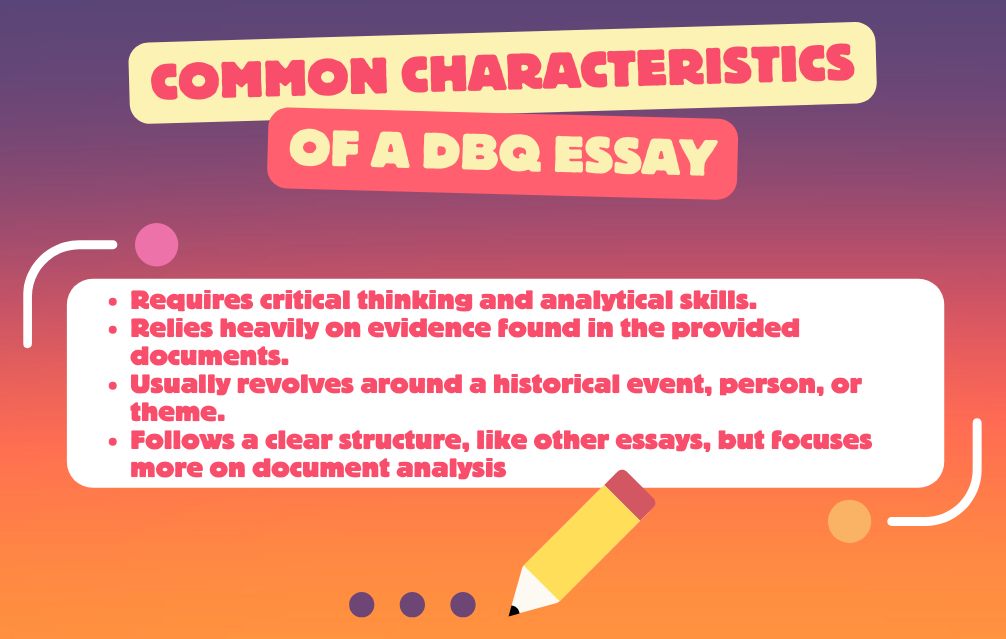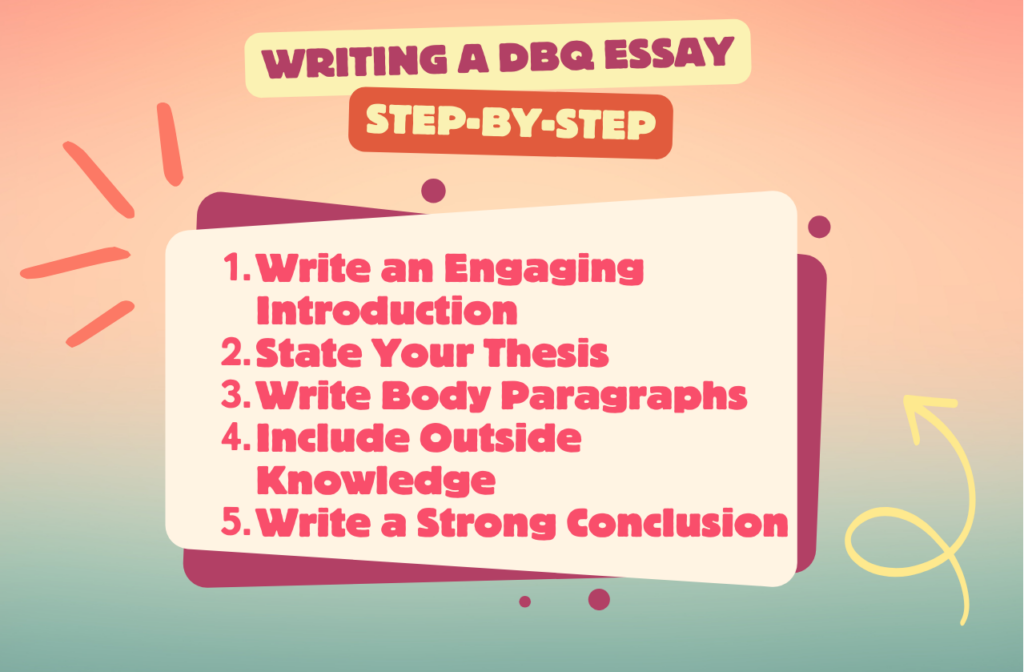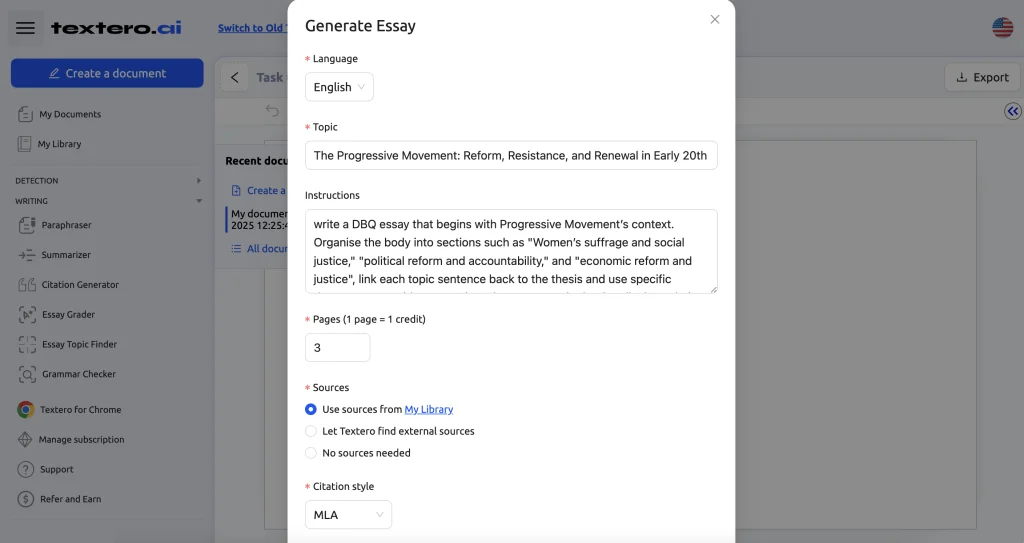How to Write a DBQ Essay

If you are faced with a DBQ essay, you might first think that you are screwed. This immediate thought seems especially valid when you realize that the whole work is about analyzing multiple documents and crafting a well-structured argument from them. But it is what it is – writing a DBQ (Document-Based Question) essay is common, particularly in AP History exams, but it can be found in other courses as well. Usually, the challenge for most students isn’t the content itself. It’s knowing how to piece together all the parts: reading, analyzing, planning, and finally, writing. So, we decided to make it our mission to walk you through every step you need to take to ace your DBQ essay with ease. Buckle up, and let’s start digging in.
DBQ Meaning: Defining the DBQ Essay Type
Before dissecting the writing, let’s clarify: What is a DBQ essay? A DBQ is a specific type of essay that asks you to analyze historical documents, usually as part of an exam or a course assignment. It challenges you to use the information from a set of sources to answer a question. The trickiest part of it all is that you have to interpret and connect the documents while forming an argument.
Unlike a traditional essay, where you’re mainly working with either your memory or research, to create a proper DBQ you need to use provided documents, which can be anything from letters, speeches, posters, or even political animations and caricatures. You’ll be expected to:
- Analyze the documents for their meaning and context.
- Use evidence from those documents to support your argument.
- Incorporate outside knowledge (especially in AP History exams) to build a stronger case.

Planning to Write a DBQ Essay: Structure
To make sure your writing as well as you stay on track with the main goal, it’s important to create a plan. A structured approach can make a world of difference when working on this type of essay, especially since it involves analyzing several documents and putting them all together into a cohesive argument. Let’s walk through how you can organize the process so you stay focused and productive.
Step 1: Understanding the Prompt
First things first, read the prompt carefully. Your prompt will guide your entire essay. What’s the specific question you’re being asked to address? Is it asking for a cause and effect, a comparison, or perhaps an evaluation of change over time? Understanding the prompt is necessary before moving forward.
Step 2: Analyze the Documents
Spend a good chunk of time looking through the documents you’re given. Don’t rush! Make notes, underline key points, and ask yourself questions like:
- Who wrote this?
- What’s the author’s point of view?
- What’s the historical context?
- How does this document relate to my essay prompt?
Step 3: Create a Preliminary Outline
Once you’ve analyzed the documents, map out your argument. Write down how you’re going to introduce the topic, form your thesis, and build your argument with the help of the documents. Think of each paragraph as a step in your argument, and make sure you know which documents you’ll use in each part.
Step 4: Time Management
If you’re working under a time crunch, like during an exam, manage your time wisely. Spend the first 10-15 minutes reading and planning. This leaves you with enough time to write and still proofread your essay.
How to Write a DBQ Essay: Step-by-Step
Now that you’ve planned, it’s time to write. Here’s a step-by-step breakdown of how to work out each part of your DBQ essay, and some instructions for your first draft with Textero.

Write an Engaging Introduction
Your introduction sets the stage for your reader. Start with a hook that introduces the historical context of the DBQ question and then lead into your thesis statement. Your thesis should clearly answer the prompt and give a preview of your argument. If you feel that you lack words to explain all the essential points, feel free to use our AI paragraph expander to come up with an abstract that meets academic requirements.
Example: “By the early 20th century, the Progressive Movement had swept through the United States, seeking political, economic, and social reform. Through the analysis of various documents, it becomes evident that the movement gained significant momentum due to its strong cultural influence and the widespread desire for change.”
State Your Thesis
Your thesis is the backbone of your essay. It’s the statement that you’ll support with evidence from the documents. A strong DBQ thesis isn’t just a restatement of the question. It should present a clear argument or point of view.
Example: “The Progressive Movement gained social, political, and economic influence from 1890 to 1920 by addressing the country’s growing inequality and empowering citizens through grassroots activism.”
Write Body Paragraphs
Each body paragraph should focus on a specific aspect of your argument. Begin with a topic sentence that ties back to your thesis, and then introduce the documents you’ll be using as evidence. It’s important to analyze these documents, not just summarize them. Explain how each document supports your argument, and don’t forget to mention the author’s perspective, the historical context, or the document’s purpose.
Example: “The push for women’s suffrage was a key element of the Progressive Movement, as seen in Document A, a suffragette’s letter that highlights the growing demand for equal voting rights. This was further echoed in Document B, where a political cartoon mocks the opposition to women’s suffrage, illustrating the growing public support for the cause.”
No surprise, this is the hardest part of any writing — actually sticking the “meat” on the “bones”. If writer’s block is pressing too much on your shoulders, gain some inspiration by getting a draft from Textero’s AI Essay Writer. In your account, click the button “Generate essay” after opening a new document.

Provide your topic and instructions, as well as the number of pages, citations, and types of sources you want to use. We will use the same DBQ essay example about the Progressive Movement. Here’s what we did:

You can see the full example further in this post if you’re interested, wink-wink. Moreover, when you use help from an AI writer, do not neglect an opportunity to humanize your writing in a few clicks; you can use our AI fixer, and it will do all the work for you.
Include Outside Knowledge
One of the distinguishing features of a DBQ essay, particularly in AP exams, is the inclusion of outside knowledge and materials. This means incorporating information that isn’t directly mentioned in the documents but is relevant to your argument.
Example: “Beyond the documents provided, it’s important to note that the 19th Amendment, which granted women the right to vote, was directly influenced by the activism during World War I when women took on roles traditionally held by men.”
Write a Strong Conclusion
Finish your essay by restating your thesis in a new way. Summarize your key points and explain the significance of your argument. Why does your argument matter in the larger historical context?
DBQ Example Essay
To give you a clearer picture of how to write a DBQ essay, here’s a brief example put together with Textero on the topic of the Progressive Era in the United States.
❗️Remember, this is only a draft and still requires further editing by a human, like any generated text. The reference provided is meant to show a formatting example.
Prompt: Write a DBQ essay that begins with the Progressive Movement’s context. Explain how the Progressive Movement gained social, political, and cultural influence from the 1890s to the 1920s. Organize the body into sections such as “Women’s suffrage and social justice,” “Political reform and accountability,” and “Economic reform and justice”, link each topic sentence back to the thesis, and use specific documents as evidence. Analyze these sources in depth, talk about their historical context, the authors’ perspectives, and their significance in supporting the overall argument, and then conclude by summarizing the main points and reaffirming how the Progressive Movement changed American society.
The Progressive Movement: Reform, Resistance, and Renewal in Early 20th Century America
The Progressive Movement emerged in the late 19th century as a response to various societal challenges in America. Rapid urbanization, industrialization, and immigration created significant social issues, including poverty, labor exploitation, and political corruption. Key figures such as Theodore Roosevelt and Jane Addams, important to this reform movement, advocated for policies about the needs of the working population and marginalized communities. Roosevelt, as a president, pushed for regulatory reforms that curbed corporate power, while Addams founded Hull House to provide social services and educational opportunities to immigrants (Maleh).
Various organizations and grassroots campaigns sprang up in support of social reforms. These included efforts such as better labor rights, improved working conditions, and public health initiatives. The growing awareness of social injustices forced the public to want change which has led to widespread advocacy for women’s suffrage and social justice. This desire for equality and reform was mainly addressing the moral implications of poverty and neglect in society.
These ideas gained traction and laid the groundwork for the next wave of reforms centered on women’s suffrage. Activists recognized that empowering women politically was the first step to broader reforms. The commitment to social justice connected the fight for women’s rights with the overall goals of the Progressive Movement, creating a unified front for change in early 20th-century America.
Women’s Suffrage and Social Justice
The fight for women’s suffrage was deeply connected with the broader goals of social justice during the Progressive Movement. Leaders like Susan B. Anthony dedicated their lives to advocating for women’s rights, talking about how political equality was needed to achieve social justice. Anthony, along with other suffragists, organized rallies, marches, and campaigns to raise awareness about the importance of granting women the right to vote. These efforts included the Seneca Falls Convention in 1848 and the formation of the National American Woman Suffrage Association in 1890.
The suffrage movement also highlighted the contributions of women in society beyond traditional roles. Many women were active in labor rights, education, and public health initiatives, which showed their capability and desire for broader societal participation. The efforts of suffragists paved the way for the eventual passage of the 19th Amendment in 1920, which granted women the right to vote, and instigated discussions about women’s roles in civic life and their rights as citizens.
This expansion of rights significantly impacted American society by promoting ideas of equality and justice. Women demanded greater accountability from political leaders and laid the groundwork for more profound changes in governance.
Political Reform and Accountability
The Progressive Movement recognized that political reform and accountability were necessary to actually influence the widespread corruption that plagued American governance in the early 20th century. Activists sought to implement campaigns for direct democracy, which included measures such as the initiative, referendum, and recall. These forced citizens to propose legislation, vote directly on laws, and remove elected officials who were not serving the public interest. This grassroots engagement proved to be important in restoring faith in the political process. Now, the government acted for the people rather than for powerful interests.
Muckraking journalism played an important role in this reform effort as well. Journalists like Upton Sinclair exposed the dangers and injustices present in society, particularly in industries that prioritized profit over the welfare of workers and consumers. Sinclair’s famous work, “The Jungle,” talked about the unsanitary conditions in the meatpacking industry and it led to public outrage, as well as significant regulatory changes. Muckrakers laid bare the extent of political corruption and corporate malfeasance, urging the public to demand accountability from their leaders.
These efforts for political reform are directly connected to the growing calls for economic justice. Citizens became more aware of the intertwining of corporate interests and political power and began advocating for policies that would address not only political misdeeds but also the economic inequalities that arose from unchecked capitalism. The push for reforms such as antitrust laws and labor protections reflected a holistic vision for a fairer society. It set the stage for a broader discussion on economic reform and social equity in the coming years.
Economic Reform and Justice
The Progressive Movement brought a strong focus on economic reform and justice, as reformers recognized that political changes needed to be matched with measures that addressed economic inequalities. Activists like Eugene V. Debs became prominent voices advocating for labor rights, including the need for fair wages and safe working conditions. The labor movement gained traction with workers organizing strikes and protests to demand better treatment from employers.
Antitrust legislation was a key strategy to challenge the excessive power of corporations. The Sherman Antitrust Act of 1890, followed by the Clayton Antitrust Act of 1914, tried to target monopolies and promote competition, which were seen as threats to both economic fairness and democracy. The fight against corporate monopolies showed that a fair economy requires a level playing field where small businesses could thrive alongside larger corporations. Economic equality initiatives addressed the disparities in society, so progressives pushed for reforms such as income taxes on the wealthy and social welfare programs to support the most vulnerable. These efforts aimed to create a society where everyone had the opportunity to succeed, regardless of their background. The legacy of the Progressive Movement can be seen in the ongoing struggles for economic equity that continue to resonate today.
The Progressive Movement’s impact from the 1890s to the 1920s was profound, as evidenced by its significant social, political, and economic reforms. Through passionate advocacy for women’s suffrage and social justice, the implementation of political reforms directed toward reducing corruption, and the need for economic justice, the movement changed American society. The documents analyzed—ranging from personal appeals and satirical cartoons to official government reports and legislative debates—provide compelling evidence of the movement’s lasting legacy. The Progressive Movement not only addressed the immediate challenges of its era but also laid the groundwork for a more inclusive, accountable, and equitable nation.
References
- Maleh, Ass.Lec Khaled Razak. “The Impact of the Progressive Movement on the Domestic Politics of US President Theodore Roosevelt (1901 – 1908)”. Thi Qar Arts Journal, Thi Qar Arts Journal, 2022, https://doi.org/10.32792/tqartj.v2i38.326.
Conclusion
Writing a DBQ essay might feel like juggling a lot of different elements—document analysis, thesis writing, and incorporating outside knowledge—but with the right structure and plan, it’s completely doable. Remember, staying organized, managing your time correctly, and most importantly, practicing are the key to crafting a quality piece!
FAQ
What is a DBQ essay?
A DBQ (Document-Based Question) essay is a type of writing assignment that usually shows up in history exams, especially in AP courses like AP U.S. History or AP European History. The cool part about a DBQ is that you’re given a bunch of documents—think letters, speeches, or even political cartoons—that you need to analyze. The goal here is to use these documents to answer a question while building a strong argument. The challenge lies in reading between the lines, understanding the historical context, and connecting the dots to form a solid essay that makes sense of the question you’re asked.
How to format a DBQ essay?
Formatting a DBQ essay isn’t too different from writing any other essay. You still need to follow a basic structure: introduction, body paragraphs, and a conclusion. Here’s a breakdown:
- Introduction: Start with a brief background on the topic, then present your thesis statement (this is your argument).
- Body Paragraphs: Each paragraph should focus on one key point or argument that supports your thesis. Use evidence from the documents, and don’t forget to analyze them! Also, try to sprinkle in some outside knowledge to show a deeper understanding of the topic.
- Conclusion: Wrap up by restating your thesis in a new way and summarizing your key points.
It’s important to keep your essay organized, so make sure each paragraph flows logically into the next. And of course, don’t forget to cite the documents (e.g., “According to Document A…”).
How to start a DBQ essay example?
Starting a DBQ essay can feel a little intimidating, but once you’ve got a plan, you are off to a smooth work process. A strong introduction will grab your reader’s attention and set up your argument. Begin by briefly setting the historical scene or providing context that ties to the essay prompt. Then, go right into your thesis statement that clearly states your argument or answer to the question.
For example, let’s say the prompt asks how the Progressive Movement gained influence from 1890 to 1920. Your introduction might look something like this:
“The Progressive Era marked a significant period of reform in the United States, as activists sought to address economic inequality, political corruption, and social injustice. Through an analysis of several key documents, it’s evident that grassroots movements, along with changing public opinion, allowed the Progressives to gain widespread influence during this time.”
How many paragraphs is a DBQ essay?
A typical DBQ essay includes an introduction, at least 3 body paragraphs, and a conclusion—though this can vary depending on the exam or teacher’s guidelines. So in total, the length may vary somewhere between five to six paragraphs. Note, however, that each body paragraph should dive into one aspect of your argument and use evidence from the documents to support it. The more clearly you organize your thoughts and back them up with evidence, the stronger your essay will be.



